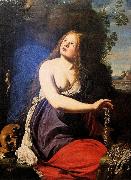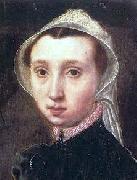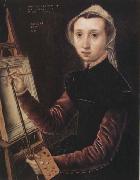|
Here are all the paintings of Catharina Van Hemessen 01
| ID |
Painting |
Oil Pantings, Sorted from A to Z |
Painting Description |
| 73611 |
 |
Sainte Marie Madeleine renoncant aux richesses de ce monde |
Date first quarter of the 17th century
Medium peinture X l'huile; bois
Dimensions 123.3 H, 94.1 L
cyf |
| 79226 |
 |
Self portrait of Catherina van Hemessen |
1548
cyf |
| 79987 |
 |
Self portrait of Catherina van Hemessen |
Deutsch: Selbstporträt von Catharina van Hemessen.
Date 1548
cyf |
| 26740 |
 |
Self-Portrait |
mk52
1548
Tempera onwood
32x25cm
Kunstmuseum,Basle
|
|
|
| Catharina Van Hemessen
|
| 1528-after1587
was a Flemish Renaissance painter. She is the earliest female Flemish painter for whom there is verifiable extant work. As with many Renaissance female painters, she was the daughter of a painter, Jan Sanders van Hemessen (c. 1500-after 1563), who was likely her teacher. She went on to create portraits of wealthy men and women often posed against a dark background. Included in her body of work is a self-portrait done in Basel. She has inscribed the painting with the year, 1548, and her age, 20 years. Her success is marked by her good standing in the Guild of St. Luke and her eventual position as teacher to three male students. Van Hemessen gained an important patron in the 1540s, Maria of Austria, who served as regent of the Low Countries for her brother Charles V. In 1554, she married Christian (or Christien) de Morien, an organist at the Antwerp Cathedral, which was at that time an important post. In 1556, when Maria resigned her post and returned to Spain, Caterina and her husband also moved, on invitation of her patron, to Spain. And two years later, when Maria died, Caterina was given a sizeable pension for life. Caterina and her husband returned to Antwerp. She was mentioned in Guicciardini's Description of the Low Countries of 1567 as one of the living women artists. She died after 1587. She mainly created portraits characterized by realism. The sitters, often seated, were usually seen against a dark or neutral ground. This type of framing and setting made for an intimate portrait. There are no extant works from after 1554, which has led some historians to believe her artistic career might have ended after her marriage. Van Hemessen is often given the distinction of creating the first self-portrait of an artist, of either gender, depicted seated at an easel.
|
|


